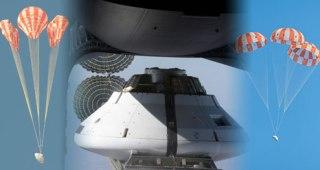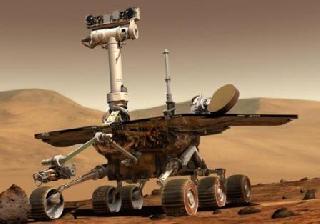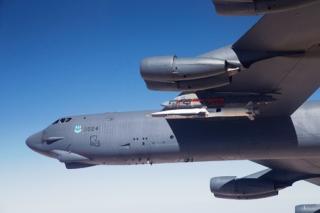
Orion Parachute Drop Test on May 1, 2013. A NASA photo.
WASHINGTON (BNS): A test version of NASA's Orion spacecraft landed safely during a simulation of two types of parachute failures.
In the test carried out on 1 May in Yuma, Arizona, the mock capsule was travelling about 250 mph when the parachutes were deployed.
That is the highest speed the craft has experienced as part of the test series designed to certify Orion's parachute system for carrying humans, NASA said.
Engineers rigged one of the test capsule's two drogue parachutes not to deploy and one of its three main parachutes to skip its first stage of inflation after being extracted from a plane 25,000 feet above the Arizona desert.
Drogue parachutes are used to slow and reorient Orion while the main parachutes inflate in three stages to gradually slow the capsule further as it descends.
The failure scenario, one of the most difficult simulated so far, will provide data engineers need for human rating the parachute system, it said.
"The tests continue to become more challenging, and the parachute system is proving the design's redundancy and reliability," said Chris Johnson, NASA's project manager for the Orion parachute assembly system.
"Testing helps us gain confidence and balance risk to ensure the safety of our crew."
Orion has the largest parachute system ever built for a human-rated spacecraft. The canopies of the three main parachutes can cover almost an entire football field. After reentering Earth's atmosphere, astronauts will use the parachutes to slow the spacecraft for a splashdown in the Pacific Ocean.
Orion's next Earth-based parachute test is scheduled for July, when the test capsule will be released from 35,000 feet, a higher altitude than ever before.
The first test of the parachutes after travelling in space will be during Exploration Flight Test-1 in 2014, when an unscrewed Orion will be returned from 3,600 miles above Earth's surface. The spacecraft will be travelling at about 340 mph when the parachutes deploy.
 Previous Article
Previous Article Next Article
Next Article













The Indian Air Force, in its flight trials evaluation report submitted before the Defence Ministry l..
view articleAn insight into the Medium Multi-Role Combat Aircraft competition...
view articleSky enthusiasts can now spot the International Space Station (ISS) commanded by Indian-American astr..
view article